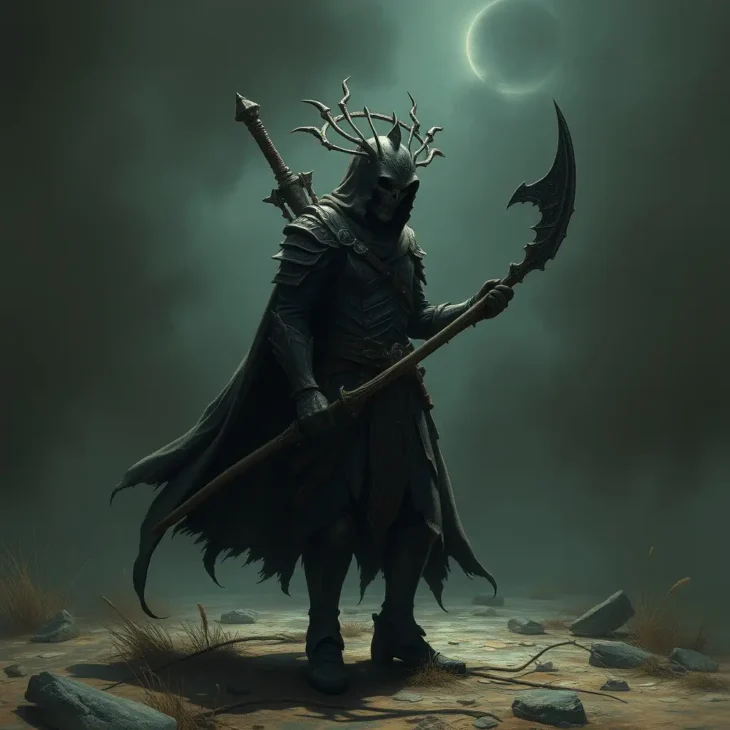The Pontianak’s Cradle – Malaysia

Dreamer’s Story:
Siti, a 30-year-old mother from Johor, sat before me, her face pale and her hands trembling slightly as she recounted her nightmare. “I’ve had bad dreams before,” she began, her voice quiet and anxious, “but this one… this one was different. It felt so real, like it was more than just a dream.”
She took a deep breath before continuing. “In my dream, it was late at night, and I was walking through a quiet kampung (village). The moonlight barely lit the path, and the air was thick with a strange silence. I was holding my baby close to me, feeling uneasy but not knowing why. Everything was so still, and I could feel the cool night breeze. Then suddenly, the temperature dropped, and the air became freezing cold. I could feel the chill deep in my bones, and that’s when I heard it—a baby crying from somewhere in the trees.”
Siti’s voice faltered as she recalled the chilling details. “I knew, deep down, that I shouldn’t go near the sound. My instincts were screaming at me to run, to protect my baby and get out of there. But… something in the dream was pulling me toward it. I couldn’t help myself. I started walking closer to the trees, and the crying got louder, almost desperate. I couldn’t stop my feet from moving. It was like I was being controlled, like something was luring me in.”
She shuddered, her eyes wide with fear. “When I reached the edge of the trees, I saw it. A cradle, hanging from the branches, swaying gently in the cold wind. Inside, there was a baby. But the baby wasn’t normal. It was pale—deathly pale—and its eyes… they were hollow, like deep, black pits. It looked at me, and I froze. I wanted to run, but I couldn’t move.”
Tears welled in Siti’s eyes as she described the next terrifying moment. “Before I could even process what was happening, I felt something behind me. I turned, and there she was—a Pontianak, standing so close that I could feel her long black hair brushing against my face. Her eyes were glowing red, and her mouth twisted into a sinister grin. I could feel her cold breath on my neck. I screamed, but no sound came out. I was trapped, completely paralyzed by fear.”
Siti paused, visibly shaken by the memory. “Then I woke up, sweating and screaming. My heart was pounding, and I felt like I’d just escaped something truly evil. I haven’t been able to sleep properly since. I keep hearing that baby’s cry in my head.”
Expert Analysis:
As an expert in dream interpretation and with a deep understanding of Malay folklore, Siti’s nightmare is a chilling yet fascinating example of how cultural legends intertwine with deeply personal fears, particularly surrounding motherhood. Her dream involves one of the most terrifying figures in Southeast Asian folklore—the Pontianak—and the symbolism throughout her nightmare reveals much about her internal emotional landscape as a mother.
The Pontianak:
In Malay folklore, the Pontianak is a powerful and deeply feared spirit, believed to be the vengeful soul of a woman who died during childbirth. She is often associated with the forest and is said to lure unsuspecting people, particularly men, into the woods with the sound of a crying baby. Once lured into her trap, she attacks them, draining their blood or devouring their organs. Her appearance is unmistakable—long black hair, pale skin, and glowing red eyes. The Pontianak is said to haunt rural areas, particularly in kampung settings, which makes Siti’s nightmare all the more terrifying, as it aligns so closely with these traditional beliefs.
The crying baby in Siti’s dream is a classic lure associated with the Pontianak. It is believed that the spirit uses the sound of a baby in distress to prey on the natural instincts of those who hear it, particularly mothers who are drawn to help an innocent child. Siti, being a mother herself, is particularly vulnerable to this psychological trap, and her dream reflects her deep-seated fear of harm coming to her own child.
The Swinging Cradle and the Hollow-Eyed Infant:
The cradle swinging in the trees is another significant element in Siti’s dream. A cradle typically represents the nurturing and protection of a child, but in this context, it is placed in an eerie, unnatural environment—the trees, high above the ground. The swinging motion of the cradle could symbolize unpredictability or instability, which might reflect Siti’s subconscious fears about her ability to protect and care for her child in an unpredictable world.
The hollow-eyed infant in the cradle is a disturbing image that speaks to the primal fears of motherhood. In traditional dream interpretation, hollow eyes often symbolize emptiness, loss, or death. The infant’s hollow eyes could be a manifestation of Siti’s fear of losing her child, either physically or emotionally. It might also reflect anxieties about her own ability to meet the needs of her baby or fears of not being a good enough mother. In the context of Malay culture, where strong family bonds and the well-being of children are paramount, these fears are amplified.
The pale appearance of the baby is another chilling detail. In dream analysis, pale or sickly figures often represent illness, death, or the loss of vitality. In Siti’s case, the pale infant could symbolize her fear of her baby falling ill or being in danger, a common concern for new mothers who are constantly vigilant about their child’s well-being.
The Appearance of the Pontianak:
The appearance of the Pontianak in Siti’s dream is the most terrifying element. As the embodiment of vengeance and motherhood gone wrong, the Pontianak represents a mother’s deepest fears—the loss of a child and the ultimate failure to protect life. The Pontianak’s long black hair, often seen as a symbol of femininity and death in Malay culture, brushing against Siti’s face is a deeply unsettling moment, indicating the closeness of danger.
The silent paralysis Siti experienced when she came face-to-face with the Pontianak is another important aspect of the dream. In dream interpretation, paralysis is often linked to helplessness, anxiety, and the feeling of being trapped in a situation from which one cannot escape. This reflects Siti’s overwhelming fear of being unable to protect her child, no matter how hard she tries. In her waking life, this may stem from the pressures of motherhood, where the responsibility for a child’s well-being can sometimes feel overwhelming.
Maternal Fears and Emotional Vulnerability:
Siti’s dream is deeply tied to her maternal instincts and the emotional vulnerability that comes with being a mother. The Pontianak’s appearance at the end of her dream represents her internal fear of not being able to keep her child safe, of being haunted by the possibility of harm. The Pontianak, in this sense, is not just a supernatural figure but also a symbol of Siti’s most primal fear—the fear of losing her child or failing as a mother.
In Malay culture, motherhood is often revered, and the role of the mother is seen as sacred. However, this also means that there is immense pressure on women to protect and care for their children at all costs. The Pontianak, being a spirit that arises from a mother’s ultimate failure—dying during childbirth—serves as a haunting reminder of the fragility of life and the weight of responsibility that comes with motherhood.
The Role of Kampung in Folklore:
The setting of Siti’s dream—a kampung—is significant as well. Kampung villages are often depicted in Malay folklore as places where spirits and supernatural forces roam freely, especially at night. In rural Malaysia, stories of ghostly apparitions, especially in areas near forests or rivers, are common, and these spirits are often seen as protectors of the land or as vengeful entities.
The cold air that Siti felt as she approached the trees is another classic supernatural motif in Malay ghost stories. It is said that when spirits are near, the temperature drops suddenly, a phenomenon known as angin dingin (cold wind), and this chilling detail adds another layer of realism to Siti’s nightmare. The baby’s cry, too, is a deeply unsettling sound that plays on the instinctive human need to protect the vulnerable. In Malay folklore, hearing a baby’s cry in the forest at night is considered an omen, and most people would avoid following the sound for fear of encountering the Pontianak.
Chill Factor: 10/10
Siti’s dream is a terrifying exploration of maternal fears, deeply rooted in Malay folklore and cultural beliefs. The presence of the Pontianak and the eerie setting of the kampung create an atmosphere of dread that feels both personal and universal. The dream taps into the primal fear of losing a child, a fear that is heightened by the supernatural elements of the dream.
The Pontianak’s cradle, the hollow-eyed infant, and the feeling of helplessness all combine to make this a nightmare that is not only frightening but also emotionally devastating. For a mother, there is no greater fear than being unable to protect one’s child, and Siti’s dream captures that fear in its most chilling form.
This nightmare earns a 10/10 on the spine





